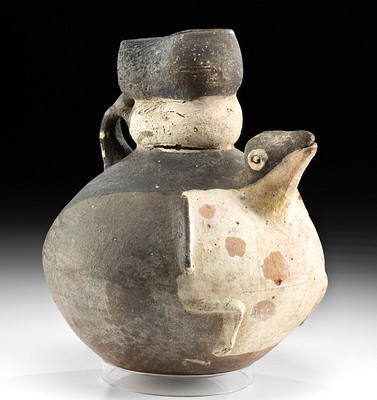Crystalline Stibnite Mineral & Pyrite Sun Discs (5)
Lot 18
About Seller
Artemis Gallery
686 S Taylor Ave, Ste 106
Louisville, CO 80027
United States
Selling antiquities, ancient and ethnographic art online since 1993, Artemis Gallery specializes in Classical Antiquities (Egyptian, Greek, Roman, Near Eastern), Asian, Pre-Columbian, African / Tribal / Oceanographic art. Our extensive inventory includes pottery, stone, metal, wood, glass and textil...Read more
Estimate:
$300 - $450
Absentee vs Live bid
Two ways to bid:
- Leave a max absentee bid and the platform will bid on your behalf up to your maximum bid during the live auction.
- Bid live during the auction and your bids will be submitted real-time to the auctioneer.
Bid Increments
| Price | Bid Increment |
|---|---|
| $0 | $25 |
| $300 | $50 |
| $1,000 | $100 |
| $2,000 | $250 |
| $5,000 | $500 |
| $10,000 | $1,000 |
| $20,000 | $2,500 |
| $50,000 | $5,000 |
| $100,000 | $10,000 |
| $200,000 | $20,000 |
About Auction
By Artemis Gallery
Oct 28, 2021
Set Reminder
2021-10-28 12:00:00
2021-10-28 12:00:00
America/New_York
Bidsquare
Bidsquare : Fauna, Flora, Stone & Bones - Fall Edition
https://www.bidsquare.com/auctions/artemis-gallery/fauna-flora-stone-bones---fall-edition-7768
Join us for a very special early Fall auction featuring fabulous fossils, rocks, and minerals, plus art depicting flora and fauna from antiquity to present day. This is one sale you won't want to miss! Artemis Gallery info@artemisgallery.com
Join us for a very special early Fall auction featuring fabulous fossils, rocks, and minerals, plus art depicting flora and fauna from antiquity to present day. This is one sale you won't want to miss! Artemis Gallery info@artemisgallery.com
- Lot Description
North America, United States, Illinois, ca. 350 million of years ago. This is a beautiful collection of 5 shimmering minerals of pyrite and stibnite! The four pyrite discs are fittingly known as pyrite suns, pyrite dollars, miner's dollars, or sun dollars, with the striations radiating from the center. While they look like fossilized sand dollars (sea urchins) these discs are naturally concentrated structures formed by pressure when pyrite is compressed between shale layers and coal seams. While pyrite is found worldwide, pyrite suns are only found in Illinois! Stibnite, also known as antimonite, is a silvery mineral that forms delicate dipyramidal structures, as seen here - absolutely mesmerizing! The silvery mineral has been used for thousands of years: ground into powder for medicine and cosmetics such as kohl eyeliner in Egypt and for fireworks in China! Size of largest pyrite disc: 3.35" W (8.5 cm); stibnite: 2.25" L x 1.5" W x 1" H (5.7 cm x 3.8 cm x 2.5 cm)
Please note that stibnite is toxic if ingested, so while beautiful, we recommend washing hands after handling and storing in a case when displaying.
Provenance: private Hagar collection, Wildwood, Missouri, USA
All items legal to buy/sell under U.S. Statute covering cultural patrimony Code 2600, CHAPTER 14, and are guaranteed to be as described or your money back.
A Certificate of Authenticity will accompany all winning bids.
PLEASE NOTE: Due to recent increases of shipments being seized by Australian & German customs (even for items with pre-UNESCO provenance), we will no longer ship most antiquities and ancient Chinese art to Australia & Germany. For categories of items that are acceptable to ship to Australia or Germany, please contact us directly or work with your local customs brokerage firm.
Display stands not described as included/custom in the item description are for photography purposes only and will not be included with the item upon shipping.
#168109Some active flaking of stibnite structures, we highly recommend storing in a case to protect crystalline structures and due to toxicity of stibnite. Pyrite discs are very good with some minor fissures along edges and radiating towards the center.Condition
- Shipping Info
-
All shipping is handled in-house for your convenience. Your invoice from Artemis Gallery will include shipping calculation instructions. If in doubt, please inquire BEFORE bidding for estimated shipping costs for individual items.
-
- Buyer's Premium



 EUR
EUR CAD
CAD AUD
AUD GBP
GBP MXN
MXN HKD
HKD CNY
CNY MYR
MYR SEK
SEK SGD
SGD CHF
CHF THB
THB












